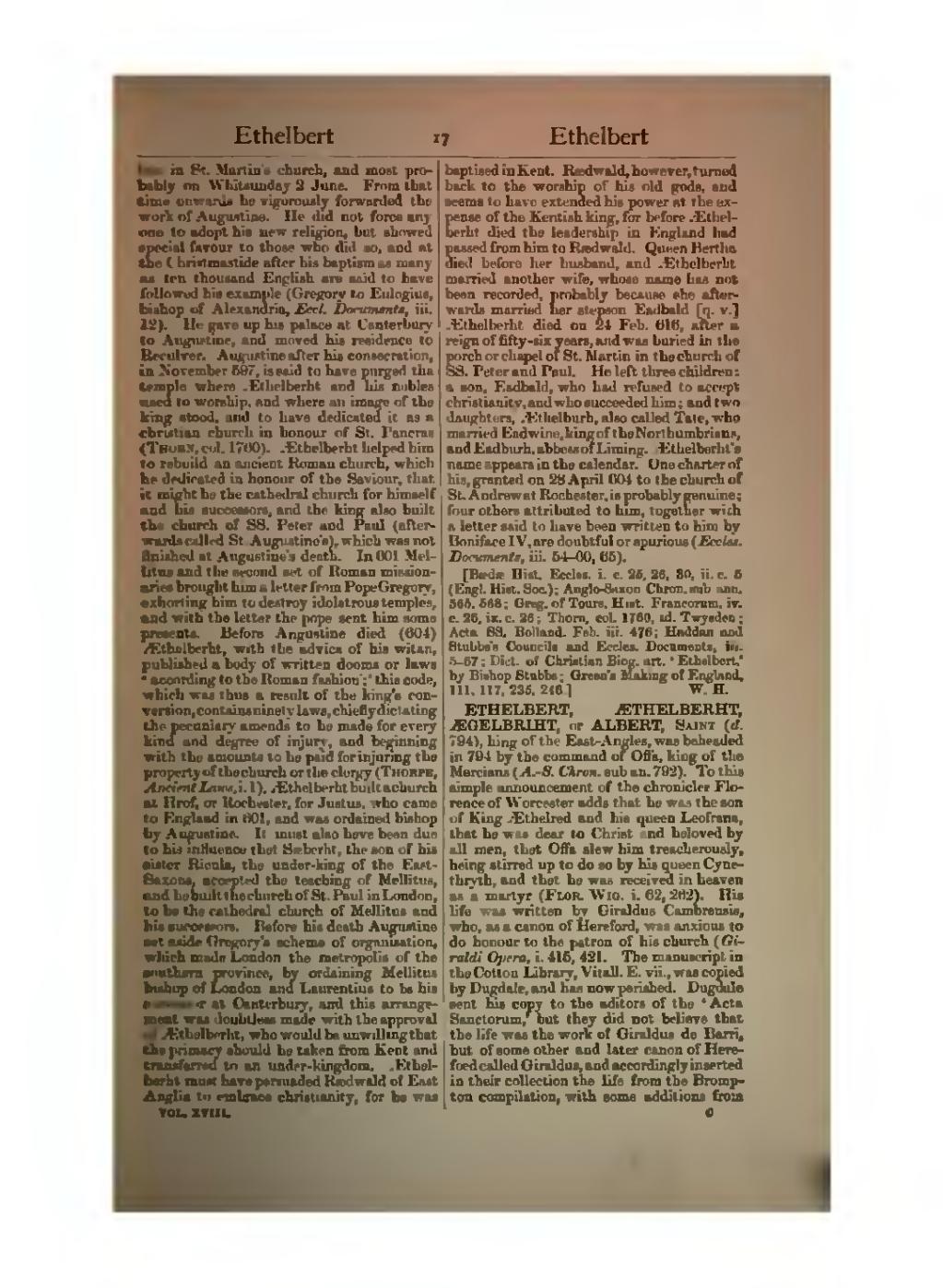less in St. Martin's church, and most probably on Whitsunday 2 June. From that time onwards he vigorously forwarded the work of Augustine. He did not force any one to adopt his new religion, but showed special favour to those who did so, and at the Christmastide after his baptism as many as ten thousand English are said to have followed his example (Gregory to Eulogius, bishop of Alexandria, Eccl. Documents, iii. 12). He gave up his palace at Canterbury to Augustine, and moved his residence to Reculver. Augustine after his consecration, in November 597, is said to have purged the temple where Æthelberht and his nobles used to worship, and where an image of the king stood, and to have dedicated it as a christian church in honour of St. Pancras (Thorn, col. 1760). Æthelberht helped him to rebuild an ancient Roman church, which he dedicated in honour of the Saviour, that it might be the cathedral church for himself and his successors, and the king also built the church of SS. Peter and Paul (afterwards called St. Augustine's), which was not finished at Augustine's death. In 601 Mellitus and the second set of Roman missionaries brought him a letter from Pope Gregory, exhorting him to destroy idolatrous temples, and with the letter the pope sent him some presents. Before Augustine died (604) Æthelberht, with the advice of his witan, published a body of written dooms or laws ‘according to the Roman fashion;’ this code, which was thus a result of the king's conversion, contains ninety laws, chiefly dictating the pecuniary amends to be made for every kind and degree of injury, and beginning with the amounts to be paid for injuring the property of the church or the clergy (Thorpe, Ancient Laws, i. 1). Æthelberht built a church at Hrof, or Rochester, for Justus, who came to England in 601, and was ordained bishop by Augustine. It must also have been due to his influence that Sæberht, the son of his sister Ricula, the under-king of the East-Saxons, accepted the teaching of Mellitus, and he built the church of St. Paul in London, to be the cathedral church of Mellitus and his successors. Before his death Augustine set aside Gregory's scheme of organisation, which made London the metropolis of the southern province, by ordaining Mellitus bishop of London and Laurentius to be his successor at Canterbury, and this arrangement was doubtless made with the approval of Æthelberht, who would be unwilling that the primacy should be taken from Kent and transferred to an under-kingdom. Æthelberht must have persuaded Rædwald of East Anglia to embrace christianity, for he was baptised in Kent. Rædwald, however, turned back to the worship of his old gods, and seems to have extended his power at the expense of the Kentish king, for before Æthelberht died the leadership in England had passed from him to Rædwald. Queen Bertha died before her husband, and Æthelberht married another wife, whose name has not been recorded, probably because she afterwards married her stepson Eadbald [q. v.] Æthelberht died on 24 Feb. 616, after a reign of fifty-six years, and was buried in the porch or chapel of St. Martin in the church of SS. Peter and Paul. He left three children: a son, Eadbald, who had refused to accept christianity, and who succeeded him; and two daughters, Æthelburh, also called Tate, who married Eadwine, king of the Northumbrians, and Eadburh, abbess of Liming. Æthelberht's name appears in the calendar. One charter of his, granted on 28 April 604 to the church of St. Andrew at Rochester, is probably genuine; four others attributed to him, together with a letter said to have been written to him by Boniface IV, are doubtful or spurious (Eccles. Documents, iii. 54–60, 65).
[Bædæ Hist. Eccles. i. c. 25, 26, 30, ii. c. 5 (Engl. Hist. Soc.); Anglo-Saxon Chron. sub ann. 565, 568; Greg. of Tours, Hist. Francorum, iv. c. 26, ix. c. 26; Thorn, col. 1760, ed. Twysden; Acta SS. Bolland. Feb. iii. 476; Haddan and Stubbs's Councils and Eccles. Documents, iii. 5–67; Dict. of Christian Biog. art. ‘Ethelbert,’ by Bishop Stubbs; Green's Making of England, 111, 117, 235, 246.]
ÆTHELBERHT, ÆTHELBERHT, ÆGELBRIGHT, or ALBERT, Saint (d. 794), king of the East-Angles, was beheaded in 794 by the command of Offa, king of the Mercians (A.-S. Chron. sub an. 792). To this simple announcement of the chronicler Florence of Worcester adds that he was the son of King Æthelred and his queen Leofrana; that he was dear to Christ and beloved by all men, that Offa slew him treacherously, being stirred up to do so by his queen Cynethryth, and that he was received in heaven as a martyr (Flor. Wig. i. 62, 262). His life was written by Giraldus Cambrensis, who, as a canon of Hereford, was anxious to do honour to the patron of his church (Giraldi Opera, i. 415, 421. The manuscript in the Cotton Library, Vitell. E. vii., was copied by Dugdale, and has now perished. Dugdale sent his copy to the editors of the ‘Acta Sanctorum,’ but they did not believe that the life was the work of Giraldus de Barri, but of some other and later canon of Hereford called Giraldus, and accordingly inserted in their collection the life from the Brompton compilation, with some additions from
